

 |
||
 |
||
Vol. 10 (2): November 2007 |
||
Algeria / Croatia / Greece / Madeira / Mauritania & Western Sahara / Morocco / Turkey
Morocco
|
|||||||||||||||||||||||||||||||||||||||||||||||||||||
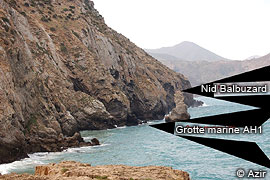 |
|
|
Caves under threat at the Tara Youssef cliff. |
Al-Hoceima National Park is situated on the Moroccan Mediterranean coast, approximately 150 km east of the Gibraltar Straits. Covering 48.000 ha, it is the only protected area in Morocco which also comprises a marine area (19.600 ha).
The ecological importance of the coastal zone between Cala Iris and Al-Hoceima was first recognised in 1983, and following various research and management programmes, it was formally established as Al-Hoceima National Park on 8 October 2004 by Royal Decree. Its significance also received recognition internationally by, amongst others, IUCN.
Threatened and endangered species found within the Park – its mountainous areas, cliffs and off-lying islands – include ospreys, Audouin gulls and possibly the last surviving monk seals of Mediterranean Morocco.
A 2003 report commissioned by UNEP’s Regional Activity Centre for Specially Protected Areas (Tunesi et al., 2003) emphasised the importance of marine caves within the Tara Yousssef cliffs as monk seal habitat. The cliffs, say environmentalists, are likely to suffer irreversible damage from the coast road construction project.
Opponents of the coast road believe it to be incompatible with the protection of the Al-Hoceima National Park, part of which has been recommended as an internationally-recognised Ramsar site.
They call instead for the old road to be upgraded and for the development of ecotourism and other alternative economic opportunities that will benefit the local community.
Nibani, H. 2007. Rapport justifiant la préservation de la falaise Ar-Moud Tara–Youssef. Association Azir: 1-7. [PDF ![]() 484 KB]
484 KB]
Tunesi, L., G. Mo, E. Salvati, A. Molinari, C. Rais, A. Limam, A. Benhamza, S. Benhissoune, D. Nachite, M. Zeichen, S. Agnesi, T. Di Nora, M.E. Piccione, H. Bazairi, I. Sadki. 2003. Rapport global des travaux de prospection de la partie marine du Parc National d’Al Hoceima. Projet Régional pour le Développement d’Aires Protégées Marineset Côtières dans la Région Méditerranéenne (Projet MedMPA). CAR/ASP-PAM-PNUE: 1-111.
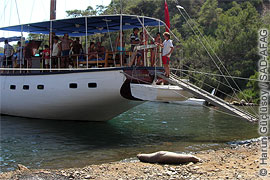 |
|
|
Informing visiting tour boats. |
Badem, Turkey’s first ex-situ rehabilitated monk seal pup, has been monitored by SAD-AFAG at her current home on Gökova Bay.
Following her return to the wild on 28 April 2007, she was observed interacting with people in Datça and Gökova [see Turkey, TMG 10(1): 2007]. Afterwards, SAD-AFAG, with the further financial support of Turkish businessman, Mustafa Koç, continued monitoring Badem and, when required, attempted to stop/reduce interactions with the passengers of visiting tour boats. Monitoring is expected to continue until the end of October 2007, when the ‘blue voyage’ season comes to an end.
The monitoring team consists of 2 people, a local SAD-AFAG representative, and a volunteer. SAD-AFAG’s Servet Deniz, the field leader, has been monitoring Badem since mid-June 2007. It should be emphasised that as of mid-November Badem’s existing location is very remote from the nearest coastal settlements; its human population is so small that it cannot be compared to the population and tourism pressures of Datça.
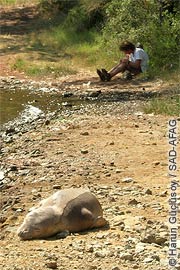 |
|
|
Monitoring Badem. |
Every day during the monitoring programme, the team ascertains the location of Badem along the open beach of the area. If any tour boats are in the vicinity, the captain, crew and passengers are warned of Badem’s presence, and are requested, as far as possible, not to interact with her.
Though some have an interest in seeing the seal, most of the people informed do not approach the animal; however, it is clear that this would not necessarily be the case if no information was provided by the monitoring team. To that end, a specially-prepared bi-lingual brochure is distributed among the visitors to this pristine area, which hosts only two tourist facilities.
Badem forages during the night and comes ashore around noon for sleeping until sunset. She does not have any injury nor any sign of malnutrition. Therefore, we believe that she has adapted well to foraging. As we observed during rehab, she is fond of eels; however, this time, instead of eel Anguillia anguillia, she forages mainly on conger, moray eels or octopus. Also, contrary to some reports, she never takes dead fish offered by people.
Updated information on Badem is fed back to the MoEF and the Coast Guard Command when necessary.
According to local observers, she has been sighted twice in the company of one and two seals.
We expect the winter season to encourage her adaptation to the wild, so that interactions with summer visitors will be avoided next year. – Harun Güçlüsoy, SAD-AFAG.
SAD-AFAG Badem information brochure. [PDF ![]() 286KB]
286KB]
Video of Badem and her rehabilitation can be found on youtube.com at:
http://www.youtube.com/watch?v=XMOSb3-tGgI
http://www.youtube.com/watch?v=MolDeS241jg
For the rehab diary of Badem (English and Turkish), visit http://www.sadafag.org.
The borders of the Foça Specially Protected Area were enlarged by a decision of the Council of Ministers and appeared in the Official Gazette on 13 June 2007. SAD-AFAG had been advocating and actively campaigning for the proposal since 2004.
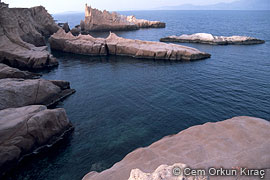 |
|
|
Siren Rocks of Orak Island. |
|
 |
|
|
Hayırsız Island. |
Foça and its vicinity represents one of the most important coastal zones in terms of marine and coastal biological diversity in Turkey, and it was first declared a Specially Protected Area (SPA) in 1990 by a decision of the Council of Ministers, with the borders depicted in the map below.
After detailed long-term field surveys had been carried out by SAD-AFAG during the Foça Pilot Project, funded by WWF, Türkiye İş Bank and Henry Ford European Conservation Awards between 1993 and 2003, an analysis of results indicated the need for enlargement of the Foça SPA. In the original design of 1990, Hayırsız Island, Kartdere Island and Cape Aslan and the uninhabited mainland coasts were excluded. Following SAD-AFAG’s proposal to the government, the enlargement of the Foça SPA was announced in early 2004 by the Minister of Environment and Forest (MoEF), Osman Pepe, in a joint press conference with SAD-AFAG held in the Çiragan Palace in Istanbul. [See Turkish government pledges 5 new protected areas for the Monk Seal, TMG 7 (1): June 2004]
As agreed by the MoEF before the press conference, the Minister also made a keynote speech in which he emphasized the importance of protecting the endangered monk seal along Turkish coasts, and pledged that the 5 high-priority Important Monk Seal Sites will have improved protection status by becoming ‘Species Protection/Management Areas’ according to IUCN criteria; as the first step towards that aim, the Minister announced, the Foça SPA would be enlarged.
After the joint press conference, SAD-AFAG maintained close contact with the MoEF and the Authority for Specially Protected Areas (ASPA) in Ankara and continued lobbying, also within the National Monk Seal Committee meetings, until that commitment was realised.
Following a review by ASPA officials, the Foça SPA was finally enlarged in June 2007 by 158,8% in total area and 37,6% in coastal length, as originally proposed by SAD-AFAG.
Our justification included the importance of missing islands and a mainland coastal stretch, with special emphasis on the Mediterranean monk seals (Monachus monachus), Shag (Phalacrocorax aristotelis desmarestii), Lesser kestrel (Falco naumanni) and Peregrine falcon (Falco peregrinus) found on Hayırsız and Kartdere islands, as well as Kartdere valley, including a wetland habitat with its rich bird biodiversity. With the new borders, marine and coastal species in the Foça SPA will have more protected habitat against coastal development, fish farms, illegal fishing and hunting. Navigational safety measures had already brought important advances to enhance marine environmental protection and reduce the risk of marine accidents in the sensitive marine zones within the Foça SPA [see Kirac, C.O. and H. Güçlüsoy in Recent Publications].
Some TMG readers may remember that Foça was the first coastal area where a long-term pilot study for the conservation of the monk seal was conducted between 1992 and 2002. During the research, 9 seals were identified. Foça coasts and adjacent islands have been used for resting, breeding and foraging by the monk seals in the newly established areas very frequently.
As a conclusion, one may judge now that the marine and coastal protected area in the Foça region has reached a size covering all the important habitats which still remain fairly undisturbed or unspoiled. And finally, NGOs play important roles in guiding the decision-making for nature conservation and may contribute towards the protection of wildlife and natural habitats with a systematic approach using scientific tools. – Cem Orkun Kıraç and Harun Güçlüsoy, SAD-AFAG.
Foça SPA, Then and Now
|
|
ORIGINAL |
NEW |
INCREASE (%) |
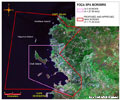 |
|
TOTAL AREA (km2) |
27,58 |
71,38 |
158,8 |
|
|
SEA AREA (km2) |
15,16 |
50,55 |
233,4 |
|
|
LAND AREA (km2) |
12,42 |
20,83 |
67,7 |
|
|
COASTAL STRETCH (km) |
35,14 |
48,36 |
37,6 |
|
|
Table: Increase of total area, sea area, land area and coastline in the Foça SPA following the 13 June 2007 decision. |
Map of Foça SPA with the original (1990) and new (2007) borders. |
|||
For the original wording and English translation of the Decision of the Council of Ministers, please refer to AFAG’s 2007 press release on the Foça SPA expansion. [PDF ![]() 428KB]
428KB]
Döndüren, Ö. 2007. Foça Adaları Kuşları. Yüksek Lisans Tezi. Ege Üniversitesi, Fen Fakültesi (Birds of Foça Islands. Master Thesis Study. Ege University, Faculty of Science) Izmir, Türkiye.
Güçlüsoy, H., C.O. Kiraç , N.O. Veryeri and Y. Savas. 2004. Status of the Mediterranean Monk Seal, Monachus monachus (Hermann, 1779) in the Coastal Waters of Turkey. E.U. Journal of Fisheries & Aquatic Sciences 21 (3-4): 201–210. [PDF ![]() 925KB]
925KB]
Güçlüsoy, H. and Y. Savaş. 2003. Status of the Mediterranean Monk Seal, Monachus monachus, in the Foça Pilot Monk Seal Conservation Area, Turkey. Zoology in the Middle East. 28:5-16, Heidelberg, Germany.
Karauz Kiraç, S. and C.O. Kiraç. 1995. Population and Distribution of Breeding Sea Bird Colonies on Foça Islands, Aegean Sea, Turkey. MEDMARAVIS Conference, 11-16 April 1995. Tunisia.
Kiraç, C.O. and H. Güçlüsoy. 2007. Regulation on Ships Navigation to Reduce Risk of Marine Accidents in Favour of Marine and Coastal Ecosystems on the Aegean Coast of Turkey. CIESM 38th Congress, 3-7 April 2007, Istanbul, Turkey. [PDF ![]() 114KB]
114KB]
The fascination and the colours of the Cilician sea strike again! The small group of 6 ecotourists, led by GFM-Gruppo Foca Monaca, returned to Italy enthusiastic but sad to be back home: they had been visiting, at the end of October, the area where the monk seal conservation project of the Levant Nature Conservation Society takes place, following an agreement and a formula already well established in the past.
The seals made their appearance on three occasions. Sea turtles (Caretta caretta and Chelonya midas) were also seen during the group excursions on the local fishermen’s boats, as well as many rare birds, following a bird-watching day at the Goksu river delta.
Another alternative and very interesting activity was a visit to the forests (hosting the rare Cedar of Lebanon) and old villages on the wild Taurus mountains, dominating most of the southern Turkish coasts: a jump back to the early 20th century. It is very important to underline (as some speculations have been made by uninformed and unfriendly people) that the visitors never entered any sea cave, but followed the strict rules requested by the Levant experts (Serdar Sekinan was leading the group): they were looking at seals only from specific observation points, causing no stress at all to the seals, whose behaviour always appeared very calm and natural.
Two seals were seen fishing together, and the same – on different days – were again seen entering a cave which seems to be one of their most favourite. As in the past, the visit did involve as far as possible local people, first of all starting with the fishermen (only their boats were used for sea excursions), but also using all local facilities (bus, hotel, restaurants). The support that the group provided to Levant Nature included a donation to the association for its important activities. GFM (and the WWF-Italy ‘Panda Avventure’ excursions agency) are planning to continue organizing the trips in 2008 (June and October), probably including also a trip in July to the Madeira monk seal project (contacts are underway). Furthermore, GFM has ‘adopted’ Levant Nature Conservation Society to support as far as possible its activities, and it is studying the possibility of promoting other ‘dedicated’ supporting events for 2008.
2008’s GFM excursion programmes will be published by the end of this year on the GFM web site: www.focamonaca.it. – Luigi Guarrera, GFM Italia.
The Underwater Research Society - Mediterranean Monk Seal Research Group (SAD-AFAG) and the International Fund for Animal Welfare (IFAW) undertook an extensive survey between Dalaman and Antalya, SW Turkey, in search of possible breeding caves and habitats of Mediterranean monk seals this summer. Team members spent two weeks in July 2007 on board ‘Song of The Whale’, IFAW’s marine mammal research vessel, following the entire coastline. Each cave judged suitable for breeding was marked and carefully mapped for future studies. SAD-AFAG discovered 20 promising breeding caves overall, some bearing apparent seal traces.
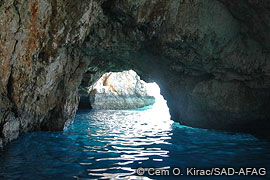 |
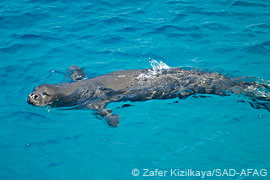 |
|
|
|
|
The research team observed two adult male monk seals at Cape Gelidonya for more than an hour. Interviews with fishermen suggest that the number of monk seals in the area is rather better than SAD-AFAG estimates. “An unspoilt coastline, together with seal traces in the caves gives us a lot of hope for the future status of seals in the region,” says researcher Harun Güçlüsoy. AFAG’s Cem Kiraç also points to other ecological highlights observed during the expedition, including the third breeding colony of the endangered Audouin's Gull (Larus audouinii) discovered in Turkey and abundant numbers of Cory’s Shearwater (Calonectris diomedea).
On 23 July 2007, the team also spotted a large male sperm whale on the offshore waters of Fethiye Bay. – Zafer Kizilkaya, SAD-AFAG.
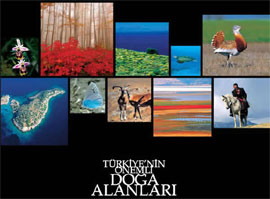 |
|
|
|
A book entitled ‘Key Biodiversity Areas of Turkey’ has been published by Doga Dernegi (DD, Nature Society) in cooperation with the Turkish Ministry of Environment and Forest (MoEF) and several conservationists and academics. The publication covers all key bird species, mammals, freshwater fish, reptiles, amphibians, butterflies, dragonflies and key botanical biodiversity areas (KBAs) of Turkey in an integrated manner.
SAD-AFAG contributed to this important publication with a description of the ‘Important Monk Seal Sites of Turkey’, together with the general status appraisal of the species and its habitats, major threats and other relevant information. In two volumes and 1,112 pages, this book provides a full overview of all 305 Key Biodiversity Areas in Turkey defined until now.
Published this year, the book took 2 years to prepare, and involved 144 writers, 100 photographers, 31 consultants and many other contributors from universities, NGOs, governmental bodies and freelance conservationists. – Münevver Çakir, SAD-AFAG.
The Foça Specially Protected Area will soon be patrolled by a new speed boat. As reported in the November 2006 issue of TMG [Campaign to replace patrol boat in Foça SPA], SAD-AFAG had contacted and continued to lobby the Authority for Specially Protected Areas (ASPA) for a new patrol boat. The issue was given added urgency by the fact that guarding within the SPA had not taken place since 2004, when the previous patrol boat, ‘Çevre’ became unusable.
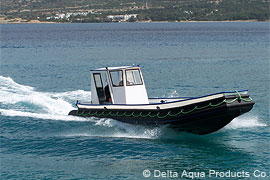 |
|
|
New patrol boat to be used in the Foça SPA. |
The budget for replacement was finally approved in December 2006 and the tender announced by ASPA in spring 2007. The technical specification of the boat was prepared jointly by SAD-AFAG and the Foça Aqua Products Cooperative based on previous experience. In August this year, a contract was signed with the winning company for the manufacture of a 9-meter long High Density Polyurethane (HDPE) craft powered by a 240 HP inboard diesel engine. The boat will have an operational speed of 30 knots, sufficient to undertake effective patrolling in cooperation with the Coast Guard boats in Foça against illegal fishing activities. The boat will also be equipped with radar, fish finder and GPS. SAD-AFAG also provided a draft protocol to be signed principally between ASPA and the Foça Municipality. According to the protocol, the Foça Fishing Cooperative, whose members consist only of artisanal fishermen, will be responsible for providing the captain of the boat. Patrolling will be made based on unscheduled sorties, day and night, while SAD-AFAG may provide observers on some patrols. Following transfer of the boat from ASPA to the Foça Municipality, the Municipality will be fully responsible for its operation and maintenance costs. The patrol boat should be delivered turnkey to ASPA in Foça in December 2007 in accordance with the contract. Such a marine patrolling system, actively involving local stakeholders, was unique in Turkey when first introduced, and proved very successful during the Foça Pilot Project when the boat was run effectively. Since then, a similar marine patrolling system has been activated in Aydincik, Mersin with the patrol boat DK01 owned by SAD-AFAG. – Cem O. Kiraç and Harun Güçlüsoy, SAD-AFAG.
EndQuoteSeven European countries including France and Italy were threatened with legal action over lax fisheries controls Wednesday as part of new efforts to prevent the collapse of bluefin tuna from overfishing. Driven by the high prices from the Japanese sushi market, European fishermen have already caught their entire quota of 16,779.5 tons of bluefin tuna for 2007 and last week were ordered to stop fishing until next year. The European Commission said Wednesday that it intended to get tough with the countries that fail to police their national fishing fleets. In a statement it said that "high rates of undeclared overfishing have been singled out as a key cause of the decline of the stock." Cyprus, Greece, Italy, Malta, Portugal and Spain were sent legal letters for failing to send official data on catches to the commission. France and Italy received the same warning though theirs also referred to shortcomings in their controls. If their answers fail to satisfy the European Commission, the countries can be taken to the European Court of Justice, the European Union's highest court.
|
Copyright © 2007 The Monachus Guardian. All Rights Reserved |